
Firewood bee nest block
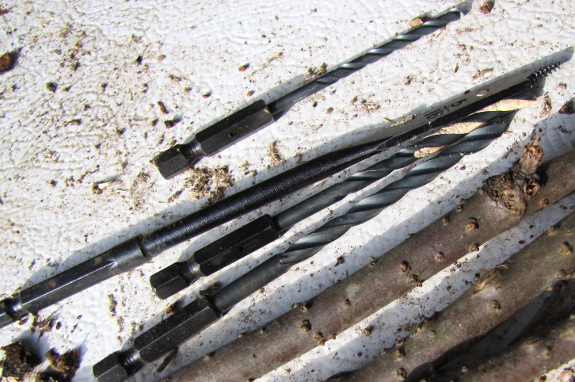
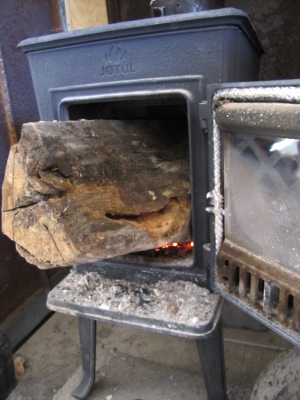 If you guessed that Mark's
mystery object was a native bee nest, you were right! You'll
read more about the theory behind creating nests for native
pollinators on
Thursday, but I can't wait to post about my experiments.
If you guessed that Mark's
mystery object was a native bee nest, you were right! You'll
read more about the theory behind creating nests for native
pollinators on
Thursday, but I can't wait to post about my experiments.
Version 1.0 uses a piece
of firewood that was too gnarly for Mark to split. I drilled one
face with holes sized 1/8, 5/32, 3/16, and 5/16 inches in diameter ---
the goal is to use a variety of sizes between 3/32 and 5/8 inches so
that we'll attract several different bee species.
Next, I wanted to
blacken the surface of the wooden nest block since a dark color is
supposed to attract bees. You can use spray paint, but I didn't
have any on hand, so I tried various methods to char the surface.
Sticking the block of firewood in the stove didn't work --- not only 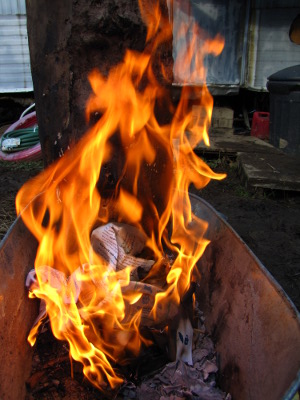 didn't the log fit, the
flames didn't want to burn the side I was focusing on.
didn't the log fit, the
flames didn't want to burn the side I was focusing on.
It was much more
effective to scoop some of the hot coals out into a galvanized tub and
light a bit of junk mail so that the flames licked the face of the
log. Those of you who like gadgets will probably have even better
luck using a propane torch.
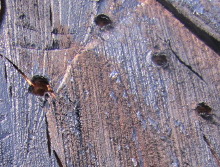
The end result was
lightly blackened wood surrounding the holes.
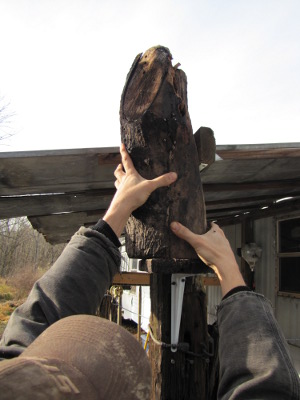 Finally,
I got Mark to mount my bee nest on the east side of one of our porch
posts. In a perfect
world, nests get early morning sun to help the bees warm up enough to
fly right after dawn, then the burrows are shaded from the full summer
heat later in the day. I also wanted to make sure that my bee
nest was somewhere we'll walk by regularly so that I'll notice if it's
being used. Hopefully this spot will do the job.
Finally,
I got Mark to mount my bee nest on the east side of one of our porch
posts. In a perfect
world, nests get early morning sun to help the bees warm up enough to
fly right after dawn, then the burrows are shaded from the full summer
heat later in the day. I also wanted to make sure that my bee
nest was somewhere we'll walk by regularly so that I'll notice if it's
being used. Hopefully this spot will do the job.
After reading further,
though, I discovered one flaw in my design. Nest blocks with lots
of holes like this one can turn into breeding grounds for bee diseases
and pests, so you need to go through a complex management scheme to
clean the nests and/or phase them out of production after a year or
two. Stay tuned for versions 2.0 and 3.0, which deal with the
pest problem in a simpler manner.
Want more in-depth information? Browse through our books.
Or explore more posts by date or by subject.
About us: Anna Hess and Mark Hamilton spent over a decade living self-sufficiently in the mountains of Virginia before moving north to start over from scratch in the foothills of Ohio. They've experimented with permaculture, no-till gardening, trailersteading, home-based microbusinesses and much more, writing about their adventures in both blogs and books.
Want to be notified when new comments are posted on this page? Click on the RSS button after you add a comment to subscribe to the comment feed, or simply check the box beside "email replies to me" while writing your comment.
- Remove comment
- Remove comment
- Remove comment
- Remove comment
